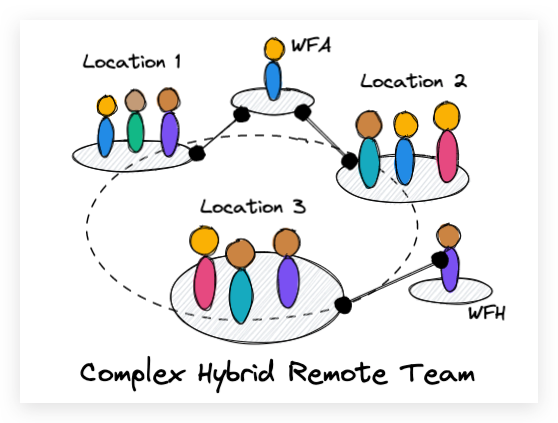Remotely Facilitating for Connection: A Manifesto

The last two years of being remote gave us isolation, distraction, rushed meetings, repeat meetings (because we didn’t finish the work) and lost participants. And it doesn’t have to be like that. It can actually be better than in person.
Working remotely for the last several years brought connections and collaborations I never would have thought possible:
- I wrote my first book remotely pairing with Johanna Rothman
- I’m working on my second book remotely pairing with April Jefferson
- I’ve helped build organizations that have spanned timezones and countries to build competitive products in the marketplace, and
- I’ve met and collaborated with some amazing facilitators, coaches and trainers in every major continent (except Antartica – let me now if you know a facilitator there)
Several colleagues felt, like me, that people missed these benefits during the pandemic. Individuals saw benefits to their health and their time to work at home, but people did not truly experience the business benefits of a collaborative remote workforce.
Thanks to Judy Rees, we came together as a remote group of practitioners to synthesize the essence of the best remote collaboration. We value the following and I’ll share some of my personal interpretations.
People and relationships over technology and tools.
Many people know me as a tool geek. I will experiment with any new online collaboration tool if I feel it solves a problem I see with online connection. However, if the tool gets in the way of collaboration, then I’m not interested.
It’s not about the tools. It’s about what new types of collaboration and connections can this tool provide?
Transparently-planned, participative processes over centralised control
In the early days of my coaching and facilitation, I focused on “controlling the space” and the people in that space. However, as I learned more forms of facilitation and coaching, I realized “holding the space” for others to create the process they needed for their work became more productive and sustainable. So I tend to use and teach more open space technology and liberating structures approaches because it gives control to the participants. They decide their best way to work.
It’s not about me as the facilitator. It’s about what processes can people learn and adapt quickly to deliver meaningful work together?
Blended forms of engagement (sync, async, video, writing, etc.) over single-mode
Avoid forcing collaboration just in video meetings. Instead, try different ways to stimulate the thinking, or the conversation, or the creation needed for the work at hand.
Remember, we don’t experience the world through just one sense. We have five senses in the human body. So when you are online, think about how you can provide Multiple Open Channels Anywhere (MOCA) so people can better experience the virtual collaboration space.
It’s not about forcing everyone into another video call. It’s about providing different ways to collaborate to provide different perspectives.
Iteration that leads to positive change over one-and-done approaches
One trap I found many people fell into during the pandemic was a set-and-forget technology solution to run meetings online. For me, I always develop Plan A and Plan B (and sometimes Plan C) in processes and tools depending on what technology problems I may encounter or how the needs of participants might shift during the session.
I’ll even reflect after each session to see what I might change around process, technology, or the next Plan B.
It’s not about over-preparing. It’s about being empathetic to the needs of the participants to accomplish the work and developing skills to adapt, even in the moment.
Fun over formality
We spend many hours at work. Why can’t you have fun?
It’s not about goofing off. It’s about enjoying the activity of work and different ways you can connect with the people to collaborate.
Join Us
If you value this type of online collaboration, then join me and my colleagues by signing the Manifesto for Online Collaboration. And check back here on my blog for other examples of how the manifesto can be applied.
